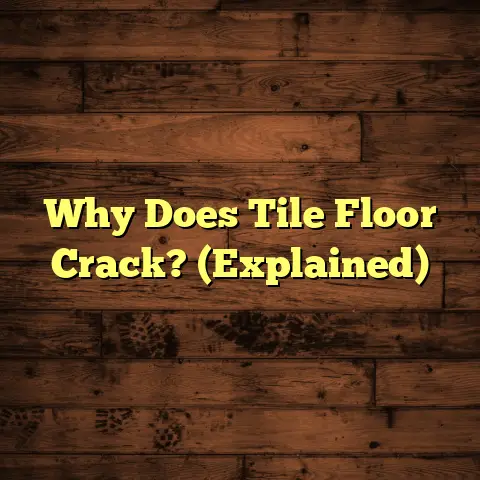Plywood to Concrete: Fastening? (4 Cracks Warning!)
I’m excited you’re here.
Ever dreamt of turning that cold, hard concrete slab in your basement into a warm, inviting living space?
I know I have! The vision of beautiful plywood flooring is tempting.
But before you dive in, hammer in hand, there’s a crucial aspect you need to understand.
I’m talking about the hidden dangers that can jeopardize your entire project: CRACKS.
Yep, those nasty lines that can ruin your floor’s appearance and compromise its structural integrity.
Over my years as a flooring contractor, I’ve seen it all, and I’m here to share my hard-earned wisdom.
In this article, we’ll explore the ins and outs of fastening plywood to concrete.
I’ll reveal the essential techniques and, more importantly, the four critical crack warnings.
Ignoring these warnings can lead to a flooring disaster you definitely want to avoid.
So, grab a coffee, settle in, and let’s get started!
1. Understanding the Materials
First things first, let’s talk about plywood and concrete.
These are the two main players in our flooring endeavor, and understanding them is crucial.
Plywood: The Warmth Provider
Plywood is an engineered wood product made from thin layers of wood veneer glued together.
- Strengths: It’s relatively inexpensive, easy to work with, and provides a warm, comfortable surface.
- Weaknesses: Plywood is susceptible to moisture damage, expansion, and contraction.
Not all plywood is created equal. For concrete applications, you’ll want to choose wisely.
- Exterior-grade plywood: This is your best bet. It’s designed to withstand moisture and resist delamination.
- Thickness: I usually recommend at least 3/4-inch plywood for a stable, long-lasting floor.
Concrete: The Unyielding Foundation
Concrete is a composite material made from cement, water, and aggregates. It’s known for its strength.
- Strengths: Concrete is strong, durable, and resistant to compression.
- Weaknesses: It’s porous, prone to cracking, and can be cold and uncomfortable.
Concrete is also a moisture magnet. It can absorb moisture from the ground, the air, or even spills.
This moisture can then transfer to the plywood, causing it to warp, swell, or even rot.
Key takeaway: Understanding the properties of plywood and concrete is the first step in avoiding disaster.
2. The Science of Fastening
Now, let’s get down to the nitty-gritty: how to actually fasten plywood to concrete.
There are several methods, each with its own pros and cons.
Fastening Methods
- Screws: Concrete screws, like Tapcons, are a popular choice. They’re strong, reliable, and relatively easy to install.
- Nails: Powder-actuated nailers can drive nails directly into concrete. However, this method can be prone to cracking the concrete.
- Adhesives: Construction adhesives can be used to glue plywood to concrete. This method is less invasive but may not be as strong as screws or nails.
- Combination: Sometimes, I’ll use a combination of methods, like adhesive and screws, for added security.
Mitigating Risks
Regardless of the method you choose, proper fastening techniques are crucial.
- Pre-drilling: Always pre-drill pilot holes before driving screws into concrete. This prevents cracking and makes installation easier.
- Spacing: Space your fasteners evenly, typically 12-16 inches apart, to distribute the load and prevent warping.
- Staggering: Stagger the seams of your plywood sheets to avoid creating weak points in the floor.
Important note: Movement and shrinkage are inevitable. Plywood expands and contracts with changes in humidity.
Concrete can also shrink as it cures.
Your fastening method must be able to accommodate this movement to prevent cracks.
3. The Four Cracks Warning
Alright, let’s dive into the heart of the matter: the four cracks you absolutely need to watch out for.
Crack #1: Shrinkage Cracks
- What it is: Shrinkage cracks occur when either the plywood or the concrete loses moisture and shrinks.
- Why it happens: Plywood is hygroscopic, meaning it absorbs and releases moisture depending on the surrounding environment. Concrete also shrinks as it cures.
-
How to prevent it:
- Acclimate the plywood: Before installation, allow the plywood to acclimate to the room’s humidity for several days.
- Use a moisture barrier: Install a vapor barrier between the concrete and the plywood to prevent moisture from migrating.
- Control humidity: Maintain a consistent humidity level in the room to minimize expansion and contraction.
Personal Story: I once worked on a project where the homeowner rushed the installation process.
They didn’t acclimate the plywood, and within a few months, shrinkage cracks started appearing.
We had to tear up the entire floor and start over. Lesson learned!
Crack #2: Settlement Cracks
- What it is: Settlement cracks occur when the concrete slab settles unevenly over time.
- Why it happens: Soil conditions, poor compaction, or changes in groundwater levels can cause concrete to shift and settle.
-
How to prevent it:
- Proper site preparation: Ensure the soil is properly compacted before pouring the concrete slab.
- Reinforcement: Use steel reinforcement in the concrete to help distribute the load and prevent cracking.
- Self-leveling compound: If the concrete slab is uneven, use a self-leveling compound to create a smooth, level surface before installing the plywood.
Real-Life Example: I inspected a floor where the concrete slab had settled significantly in one corner.
This caused the plywood to crack and buckle.
The homeowner had to hire a structural engineer to assess the damage and stabilize the foundation.
Crack #3: Expansion and Contraction Cracks
- What it is: Expansion and contraction cracks occur when the plywood and concrete expand and contract due to temperature changes and humidity fluctuations.
- Why it happens: Plywood and concrete have different coefficients of thermal expansion. This means they expand and contract at different rates.
-
How to prevent it:
- Expansion joints: Install expansion joints around the perimeter of the room and in large areas to allow for movement.
- Flexible adhesive: Use a flexible construction adhesive that can accommodate movement without cracking.
- Climate control: Maintain a consistent temperature and humidity level in the room.
Industry Data: According to the Forest Products Laboratory, wood can expand or contract by as much as 1/8 inch per foot across its width due to changes in moisture content.
Crack #4: Bond Failure Cracks
- What it is: Bond failure cracks occur when the adhesive or fasteners fail to properly bond the plywood to the concrete.
- Why it happens: Poor surface preparation, incorrect adhesive, or inadequate fastening can cause the bond to fail.
-
How to prevent it:
- Surface preparation: Clean the concrete surface thoroughly to remove any dirt, dust, or debris.
- Primer: Apply a concrete primer to improve adhesion.
- High-quality adhesive: Use a high-quality construction adhesive specifically designed for bonding plywood to concrete.
- Proper fastening: Use the correct type and number of fasteners to ensure a secure bond.
Pro Tip: I always test the adhesion of the adhesive before installing the entire floor.
Apply a small amount of adhesive to a scrap piece of plywood and concrete, let it cure, and then try to pull it apart.
If the bond fails easily, you need to use a different adhesive.
4. Step-by-Step Guide to Fastening Plywood to Concrete
Okay, now that you know the potential pitfalls, let’s walk through the proper steps for fastening plywood to concrete.
Tools and Materials:
- Plywood (exterior-grade, 3/4-inch thick)
- Concrete screws (Tapcons)
- Construction adhesive
- Vapor barrier
- Concrete primer
- Drill with concrete drill bits
- Impact driver
- Circular saw
- Tape measure
- Level
- Safety glasses
- Dust mask
Step-by-Step Instructions:
-
Prepare the Concrete Surface:
- Clean the concrete thoroughly to remove any dirt, dust, or debris.
- Use a concrete grinder or sander to smooth out any rough spots.
- Apply a concrete primer to improve adhesion.
-
Install the Vapor Barrier:
-
Lay down a vapor barrier over the concrete surface.
- Overlap the seams by at least 6 inches.
- Tape the seams with moisture-resistant tape.
-
Cut the Plywood:
-
Measure the room and cut the plywood sheets to size.
- Remember to leave a 1/4-inch expansion gap around the perimeter of the room.
-
Apply Adhesive:
-
Apply a generous bead of construction adhesive to the back of each plywood sheet.
-
Fasten the Plywood:
-
Place the plywood sheet on the concrete.
- Pre-drill pilot holes through the plywood and into the concrete.
- Drive concrete screws into the pilot holes, spacing them 12-16 inches apart.
-
Stagger the Seams:
-
Stagger the seams of the plywood sheets to avoid creating weak points in the floor.
-
Install Expansion Joints:
-
Install expansion joints around the perimeter of the room and in large areas.
Safety Precautions:
- Always wear safety glasses and a dust mask when working with concrete and plywood.
- Use a drill with a clutch to prevent over-tightening the screws.
- Work in a well-ventilated area when using adhesives and primers.
5. Case Studies and Real-Life Examples
Let’s take a look at some real-life examples of what can happen when you don’t follow these guidelines.
Case Study 1: The Basement Flood
A homeowner installed plywood flooring in their basement without a vapor barrier.
A few months later, a small leak caused the concrete slab to become saturated with water.
The plywood absorbed the moisture, warped, and developed mold. The entire floor had to be replaced.
Case Study 2: The Cracking Concrete
A contractor used a powder-actuated nailer to fasten plywood to a concrete slab.
The force of the nailer caused several cracks to form in the concrete.
Over time, these cracks widened and caused the plywood to become loose and unstable.
Successful Project: The Heated Floor
I worked on a project where the homeowner wanted to install radiant floor heating under the plywood.
We used a special type of plywood designed for heated floors and installed it with a flexible adhesive.
We also installed expansion joints to accommodate the movement caused by the temperature changes.
The result was a beautiful, warm, and comfortable floor that has lasted for years.
6. Conclusion: The Final Word on Plywood to Concrete Fastening
So, there you have it: a comprehensive guide to fastening plywood to concrete.
Remember, understanding the interplay between plywood and concrete is crucial for a successful project.
Be vigilant about the four cracks: shrinkage, settlement, expansion/contraction, and bond failure.
By following the proper techniques and taking the necessary precautions, you can create a beautiful and long-lasting floor.
Key Takeaways:
- Choose the right type of plywood.
- Prepare the concrete surface properly.
- Use a vapor barrier.
- Fasten the plywood securely.
- Install expansion joints.
- Monitor the humidity and temperature.
Call to Action:
Now, I’d love to hear from you!
Have you ever fastened plywood to concrete?
What challenges did you face? What tips can you share?
Let’s create a community of shared knowledge and expertise.
Share your experiences in the comments below!





